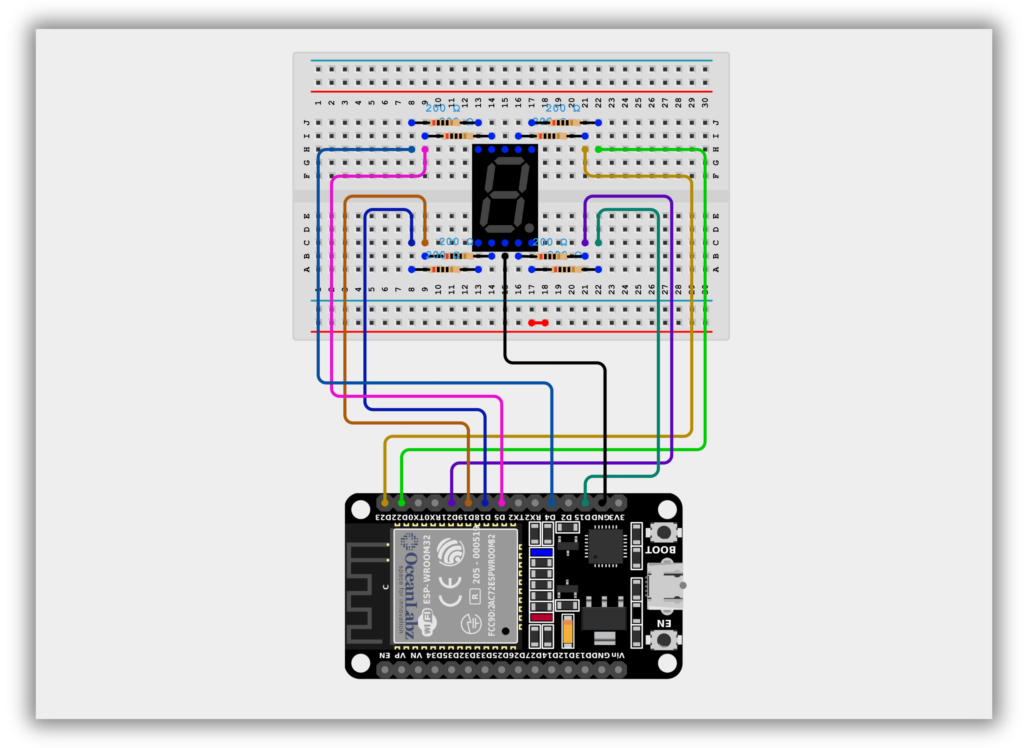Index
Introduction
A 7-segment display is used to show numeric digits using 7 LEDs (segments) labeled a–g.
Each segment is controlled individually to display numbers from 0 to 9.
Available in Common Cathode or Common Anode types.
In this tutorial, we’ll connect and control a 1-digit 7-segment display using the ESP32.
Required Components
- ESP32 Board
- 7 Segment Display
- 220 Ohm Resistor (8 Pcs)
- Jumper wires
- Breadboard
Pinout

Circuit Diagram / Wiring
- Segment (a) → ESP32 GPIO 23
- Segment (b) → ESP32 GPIO 22
- Segment (c) → ESP32 GPIO 21
- Segment (d) → ESP32 GPIO 19
- Segment (e) → ESP32 GPIO 18
- Segment (f) → ESP32 GPIO 5
- Segment (g) → ESP32 GPIO 4
- Segment (DP) → ESP32 GPIO 15
- Segment (GND) → ESP32 GND
- Use 220Ω resistors between each segment pin and the ESP32 to limit current.

Code / Programming
/*
Filename: esp32_7segment_display.ino
Description: Display digits 0–9 on a common cathode 7-segment display using ESP32
Author: www.oceanlabz.in
Modification: 1/4/2025
*/
// Define ESP32 GPIO pins connected to segments a-g
const int a = 23;
const int b = 22;
const int c = 21;
const int d = 19;
const int e = 18;
const int f = 5;
const int g = 4;
// Segment patterns for digits 1 to 9 (0 = ON for Common Cathode)
byte digits[10][7] = {
// a, b, c, d, e, f, g
{1, 1, 1, 1, 1, 1, 0}, // 0
{0, 1, 1, 0, 0, 0, 0}, // 1
{1, 1, 0, 1, 1, 0, 1}, // 2
{1, 1, 1, 1, 0, 0, 1}, // 3
{0, 1, 1, 0, 0, 1, 1}, // 4
{1, 0, 1, 1, 0, 1, 1}, // 5
{1, 0, 1, 1, 1, 1, 1}, // 6
{1, 1, 1, 0, 0, 0, 0}, // 7
{1, 1, 1, 1, 1, 1, 1}, // 8
{1, 1, 1, 1, 0, 1, 1} // 9
};
// Store segment pins in an array
const int segmentPins[7] = {a, b, c, d, e, f, g};
void setup() {
for (int i = 0; i < 7; i++) {
pinMode(segmentPins[i], OUTPUT);
}
}
void loop() {
for (int i = 1; i <= 9; i++) {
displayDigit(i);
delay(1000);
}
}
// Function to display a digit
void displayDigit(int num) {
for (int i = 0; i < 7; i++) {
digitalWrite(segmentPins[i], digits[num][i]);
}
}
Explanation
- A 7-segment display uses seven individual LEDs (a–g) to form numeric digits.
- The ESP32 controls each segment through digital GPIO pins to display numbers from 1 to 9.
- This project demonstrates how to light up each digit sequentially using a common cathode display.
Troubleshooting
- If segments are not lighting correctly, double-check wiring and pin assignments.
- For dim or no display, ensure resistors are properly rated (e.g., 220Ω) and common cathode is grounded.
- If using a common anode display, invert the HIGH/LOW logic in
digitalWrite().


